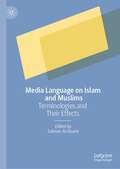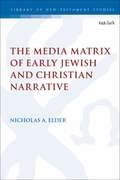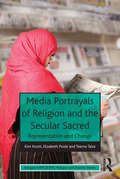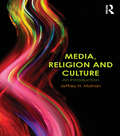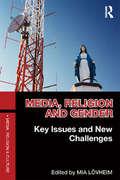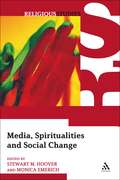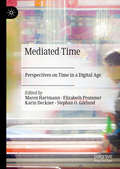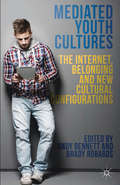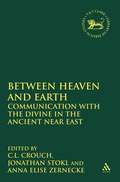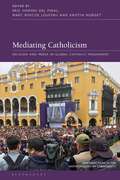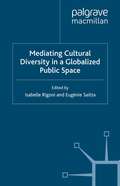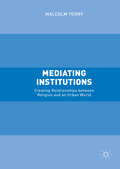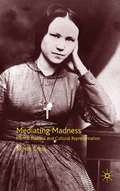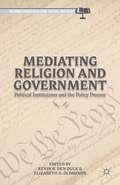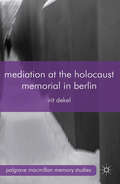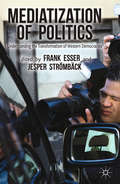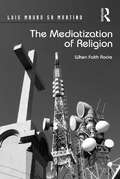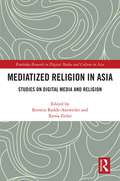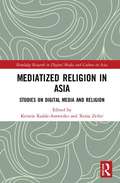- Table View
- List View
Media Language on Islam and Muslims: Terminologies and Their Effects
by Salman Al-AzamiThis book brings together contributions from ten academics and a commentary from a Muslim community leader on how the British media represent some of the most important terminologies related to Islam and Muslims. It takes a nuanced approach to language within Muslims in the media research by focusing on terminologies. Each contributor in this volume focused on one terminology and its associated words to show how the representation of these terminologies have major implications on the lives of British Muslims. The book also includes some key recommendations on the usage of these terms from the Media Style Guide of the Centre for Media monitoring - a research organisation of the Muslim Council of Britain. This book’s link with the Muslim community can be a step towards new approaches in this field where academics will engage with communities and practitioners to ensure better impact of their academic works. This book will be of interest to students, scholars and practitioners in a range of fields, including Journalism, Media and Communication Studies, English Language and Linguistics, Sociology, Cultural and Religious Studies.
The Media Matrix of Early Jewish and Christian Narrative (The Library of New Testament Studies)
by Nicholas ElderThis volume compares two seemingly dissimilar ancient texts, the Gospel of Mark and Joseph and Aseneth. The former is a product of the nascent Jesus movement and influenced by the Greco-Roman Bioi (“Lives”). It details the life, ministry, death, and resurrection of a wandering Galilean. The latter is a Hellenistic Jewish narrative influenced by Jewish novellas and Greek romances. It expands the laconic account of Joseph's marriage to Aseneth in Genesis 41 into a full-fledged love and adventure story. Generically, theologically, and concerning content the two texts are quite different.Nonetheless, Mark and Joseph and Aseneth exhibit a number of remarkable similarities. This book suggests that Mark and Joseph and Aseneth are alike because of their medium and mode of composition. Each was composed via dictation. They are “textualized oral narratives.” As such they represent one instantiation of the complex relationship between orality and textuality in early Judaism and Christianity.
The Media Matrix of Early Jewish and Christian Narrative (The Library of New Testament Studies)
by Nicholas ElderThis volume compares two seemingly dissimilar ancient texts, the Gospel of Mark and Joseph and Aseneth. The former is a product of the nascent Jesus movement and influenced by the Greco-Roman Bioi (“Lives”). It details the life, ministry, death, and resurrection of a wandering Galilean. The latter is a Hellenistic Jewish narrative influenced by Jewish novellas and Greek romances. It expands the laconic account of Joseph's marriage to Aseneth in Genesis 41 into a full-fledged love and adventure story. Generically, theologically, and concerning content the two texts are quite different.Nonetheless, Mark and Joseph and Aseneth exhibit a number of remarkable similarities. This book suggests that Mark and Joseph and Aseneth are alike because of their medium and mode of composition. Each was composed via dictation. They are “textualized oral narratives.” As such they represent one instantiation of the complex relationship between orality and textuality in early Judaism and Christianity.
Media Portrayals of Religion and the Secular Sacred: Representation and Change (AHRC/ESRC Religion and Society Series)
by Kim Knott Elizabeth PooleIs it true that Christianity is being marginalised by the secular media, at the expense of Islam? Are the mass media Islamophobic? Is atheism on the rise in media coverage? Media Portrayals of Religion and the Secular Sacred explores such questions and argues that television and newspapers remain key sources of popular information about religion. They are particularly significant at a time when religious participation in Europe is declining yet the public visibility and influence of religions seems to be increasing. Based on analysis of mainstream media, the book is set in the context of wider debates about the sociology of religion and media representation. The authors draw on research conducted in the 1980s and 2008-10 to examine British media coverage and representation of religion and contemporary secular values, and to consider what has changed in the last 25 years. Exploring the portrayal of Christianity and public life, Islam and religious diversity, atheism and secularism, and popular beliefs and practices, several media events are also examined in detail: the Papal visit to the UK in 2010 and the ban of the controversial Dutch MP, Geert Wilders, in 2009. Religion is shown to be deeply embedded in the language and images of the press and television, and present in all types of coverage from news and documentaries to entertainment, sports reporting and advertising. A final chapter engages with global debates about religion and media.
Media Portrayals of Religion and the Secular Sacred: Representation and Change (AHRC/ESRC Religion and Society Series)
by Kim Knott Elizabeth PooleIs it true that Christianity is being marginalised by the secular media, at the expense of Islam? Are the mass media Islamophobic? Is atheism on the rise in media coverage? Media Portrayals of Religion and the Secular Sacred explores such questions and argues that television and newspapers remain key sources of popular information about religion. They are particularly significant at a time when religious participation in Europe is declining yet the public visibility and influence of religions seems to be increasing. Based on analysis of mainstream media, the book is set in the context of wider debates about the sociology of religion and media representation. The authors draw on research conducted in the 1980s and 2008-10 to examine British media coverage and representation of religion and contemporary secular values, and to consider what has changed in the last 25 years. Exploring the portrayal of Christianity and public life, Islam and religious diversity, atheism and secularism, and popular beliefs and practices, several media events are also examined in detail: the Papal visit to the UK in 2010 and the ban of the controversial Dutch MP, Geert Wilders, in 2009. Religion is shown to be deeply embedded in the language and images of the press and television, and present in all types of coverage from news and documentaries to entertainment, sports reporting and advertising. A final chapter engages with global debates about religion and media.
Media, Religion and Culture: An Introduction
by Jeffrey H. MahanReligion has always been shaped by the media of its time, and today we live in a media culture that informs much of what we think and how we behave. Religious believers, communities and institutions use media as tools to communicate, but also as locations where they construct and express identity, practice religion, and build community. This lively book offers a comprehensive introduction to the contemporary field of religion, media, and culture. It explores: the religious content of media texts and the reception of those texts by religious consumers who appropriate and reuse them in their own religious work; how new forms of media provide fresh locations within which new religious voices emerge, people reimagine the "task" of religion, and develop and perform religious identity. Jeffrey H. Mahan includes case study examples from both established and new religions and each chapter is followed by insightful reflections from leading scholars in the field. Illustrated throughout, the book also contains a glossary of key terms, discussion questions, and suggestions for further reading.
Media, Religion and Culture: An Introduction
by Jeffrey H. MahanReligion has always been shaped by the media of its time, and today we live in a media culture that informs much of what we think and how we behave. Religious believers, communities and institutions use media as tools to communicate, but also as locations where they construct and express identity, practice religion, and build community. This lively book offers a comprehensive introduction to the contemporary field of religion, media, and culture. It explores: the religious content of media texts and the reception of those texts by religious consumers who appropriate and reuse them in their own religious work; how new forms of media provide fresh locations within which new religious voices emerge, people reimagine the "task" of religion, and develop and perform religious identity. Jeffrey H. Mahan includes case study examples from both established and new religions and each chapter is followed by insightful reflections from leading scholars in the field. Illustrated throughout, the book also contains a glossary of key terms, discussion questions, and suggestions for further reading.
Media, Religion and Gender: Key Issues and New Challenges (Media, Religion and Culture)
by Mia LövheimMedia, Religion and Gender presents a selection of eminent current scholarship that explores the role gender plays when religion, media use and values in contemporary society interact. The book: surveys the development of research on media, religion and culture through the lens of key theoretical and methodological issues and debates within gender studies. includes case studies drawn from a variety of countries and contexts to illustrate the range of issues, theoretical perspectives and empirical material involved in current work outlines new areas and reflects on challenges for the future. Students of media, religion and gender at advanced level will find this a valuable resource, as will scholars and researchers working in this important and growing field.
Media, Religion and Gender: Key Issues and New Challenges (Media, Religion and Culture)
by Mia LövheimMedia, Religion and Gender presents a selection of eminent current scholarship that explores the role gender plays when religion, media use and values in contemporary society interact. The book: surveys the development of research on media, religion and culture through the lens of key theoretical and methodological issues and debates within gender studies. includes case studies drawn from a variety of countries and contexts to illustrate the range of issues, theoretical perspectives and empirical material involved in current work outlines new areas and reflects on challenges for the future. Students of media, religion and gender at advanced level will find this a valuable resource, as will scholars and researchers working in this important and growing field.
Media, Spiritualities and Social Change
by Stewart M. Hoover Monica M. EmerichThis book maps emergent global practices and discourses of mediated, spiritualized social change. Bringing together scholarly perspectives from around the world and across disciplines, the authors explore how 'spiritualities' express themselves through and with media - from television to Internet, from fashion to art murals - as socially transforming voices and practices. The very fluidity of the meaning of spirituality is part of its appeal: it can service as easily as a reference to a perceived common essence of humanness as it can work to legitimate market-based practices. While the involvement of spiritual life with social transformation is certainly not peculiar to contemporary societies, what has changed is the upsurge of media in these matters. In the specific case of religion, globalization has unleashed a cascade of unexpected and unpredictable implications, many of which are consequences of the media. The authors here show ways in which media and spiritualities are engaged around the world in efforts to restructure paradigms, institutions, beliefs and practices to affect social change.
Mediated Time: Perspectives on Time in a Digital Age
by Maren Hartmann Elizabeth Prommer Karin Deckner Stephan O. GörlandExploring mediated time, this book contemplates how far (and in what ways) media and time are intertwined from a diverse set of theoretical and empirical angles. It builds from theoretical discussions concerning the question of mediation and the normative framing of time (especially acceleration) and works its way through questions of time for/of one’s own, resisting temporalities, polychronicity, in-between-time, simultaneity and other time concepts. It further examines specific time frames, imaginations of a media future and the past, questions of online journalism and multitasking or liveness. Bringing together authors from diverse backgrounds, this collection presents a rich combination of milestone articles, new empirical research, enriching theoretical work and interviews with leading researchers to bridge sociology, media studies, and science and technology studies in one of the first book-length publications on the emerging field of media and time.
Mediated Youth Cultures: The Internet, Belonging and New Cultural Configurations
by Andy Bennett Brady RobardsThis book brings together thirteen timely essays from across the globe that consider a range of 'mediated youth cultures', covering topics such as the phenomenon of dance imitations on YouTube, the circulation of zines online, the resurgence of roller derby on the social web, drinking cultures, Israeli blogs, Korean pop music, and more.
Mediating Between Heaven and Earth: Communication with the Divine in the Ancient Near East
by C. L. Crouch Jonathan Stökl Anna Elise ZerneckeThis volume brings together experts in the study of ancient prayers and divination methods to analyse the variety of means by which human beings sought to communicate with their gods and by which the gods were seen to communicate with their worshippers. In a departure from previous scholarship, the volume brings together the study of prophecy, as an intuitive form of divination, with the study of technical methods of communication and other forms of institutionalised communication such as prayer. Such a format allows divine-human communication to be studied in both directions simultaneously: the means by which the divine communicates to human beings through divination, and the means by which human beings communicate with the divine through prayer. This new perspective on the study of divine-human-divine communication allows scholars to better appreciate the way in which communication and the relationship between heaven and earth was conceived in the ancient near East.
Mediating Catholicism: Religion and Media in Global Catholic Imaginaries (New Directions in the Anthropology of Christianity)
by Eric Hoenes del Pinal, Marc Roscoe Loustau, and Kristin NorgetThis book focuses on the ethnographic study of Catholicism and media. Chapters demonstrate how people engage with the Catholic media-scape, and analyse the social, cultural, and political processes that underlie Catholic media and mediatization. Case studies examine Catholic practices in North America, Western and Eastern Europe, Latin America, South-East Asia, and Africa, providing a truly comparative, de-centred representation of global Catholicism. Illustrating the vibrancy and heterogeneity of Catholicism world-wide, the book also examines how media work to sustain larger global Catholic imaginaries.
Mediating Catholicism: Religion and Media in Global Catholic Imaginaries (New Directions in the Anthropology of Christianity)
This book focuses on the ethnographic study of Catholicism and media. Chapters demonstrate how people engage with the Catholic media-scape, and analyse the social, cultural, and political processes that underlie Catholic media and mediatization. Case studies examine Catholic practices in North America, Western and Eastern Europe, Latin America, South-East Asia, and Africa, providing a truly comparative, de-centred representation of global Catholicism. Illustrating the vibrancy and heterogeneity of Catholicism world-wide, the book also examines how media work to sustain larger global Catholic imaginaries.
Mediating Cultural Diversity in a Globalised Public Space
by Isabelle Rigoni & and Eugénie SaittaThrough enhancing reflection on the treatment of cultural diversity in contemporary Western societies, this collection aims to move the debate beyond the opposition between ethnicity and citizenship and demonstrate ways to achieve equality in multicultural and globalised societies.
Mediating Institutions: Creating Relationships between Religion and an Urban World
by Malcolm TorryThis original book studies a wide variety of mediating institutions, both organizational and non-organizational, in workplaces, residential areas, and in wider society. Focusing upon institutions in the Thames Gateway and with case studies across south-east London, Europe and the USA, Meditating Institutions highlights the importance of understanding, creating and maintaining these organizations that facilitate relationships between religious institutions and others within society. Discussing their structures and activities, the author asserts that good relationships between religious institutions and other groups in our society are essential for a cohesive and peaceful society.
Mediating Madness: Mental Distress and Cultural Representation
by S. CrossMediating Madness examines how mediations of madness emerge, disappear and interleave, only to re-emerge at unexpected moments. Drawing on social and cultural histories of madness, history of art, and popular journalism, the book offers a unique interdisciplinary understanding of historical and contemporary media representations of madness.
Mediating Religion and Government: Political Institutions and the Policy Process (Palgrave Studies in Religion, Politics, and Policy)
by Elizabeth A. Oldmixon Kevin R. den DulkThe study of religion and politics is a strongly behavioral sub-discipline, and within the American context, scholars place tremendous emphasis on its influence on political attitudes and behaviors, resultuing in a better understanding of religion's ability to shape voting patterns, party affiliation, and views of public policy.
Mediation at the Holocaust Memorial in Berlin (Palgrave Macmillan Memory Studies)
by I. DekelAnalyzing action at the Holocaust memorial in Berlin, this first ethnography of the site offers a fresh approach to studying the memorial and memory work as potential civic engagement of visitors with themselves and others rather than with history itself.
Mediatization of Politics: Understanding the Transformation of Western Democracies
by Jesper Str�mb�ck Frank EsserThe first book-long analysis of the 'mediatization of politics', this volume aims to understand the transformations of the relationship between media and politics in recent decades, and explores how growing media autonomy, journalistic framing, media populism and new media technologies affect democratic processes.
The Mediatization of Religion: When Faith Rocks
by Luis Mauro MartinoFilling a significant gap in the literature by offering a theoretical framework by which we can understand the issues of media, religion and politics Luis Mauro Sa Martino asks how can a religious denomination have any sort of influence on people in a secular age? The author presents data which suggests that the presence and influence of religion in public affairs around the world has been strongly supported by the use of media communication, and highlights the way some religions have adopted media communication and drawn on popular culture to build their message. The use of media enables a religion to reach more people, attract more members and generate more income but also increases religious influence on public matters. The book offers a number of case studies and contemporary examples to illustrate the theory, and will be essential reading for all students and scholars of media, politics and all those interested in the part religion plays in our society.
The Mediatization of Religion: When Faith Rocks
by Luis Mauro MartinoFilling a significant gap in the literature by offering a theoretical framework by which we can understand the issues of media, religion and politics Luis Mauro Sa Martino asks how can a religious denomination have any sort of influence on people in a secular age? The author presents data which suggests that the presence and influence of religion in public affairs around the world has been strongly supported by the use of media communication, and highlights the way some religions have adopted media communication and drawn on popular culture to build their message. The use of media enables a religion to reach more people, attract more members and generate more income but also increases religious influence on public matters. The book offers a number of case studies and contemporary examples to illustrate the theory, and will be essential reading for all students and scholars of media, politics and all those interested in the part religion plays in our society.
Mediatized Religion in Asia: Studies on Digital Media and Religion (Routledge Research in Digital Media and Culture in Asia)
by Sophie Grace Chappell Marcel Van AckerenThis edited volume discusses mediatized religion in Asia, examining the intensity and variety of constructions and processes related to digital media and religion in Asia today. Individual chapters present case studies from various regions and religious traditions in Asia, critically discussing the data collected in light of current mediatization theories. By directing the study to the geographical, cultural and religious contexts specific to Asia, it also provides new material for the theoretical discussion of the pros and cons of the concept mediatization, among other things interrogating whether this concept is useful in non-’Western’ contexts."
Mediatized Religion In Asia (Routledge Research In Digital Media And Culture In Asia Ser.)
by Kerstin Radde-Antweiler Xenia ZeilerThis edited volume discusses mediatized religion in Asia, examining the intensity and variety of constructions and processes related to digital media and religion in Asia today. Individual chapters present case studies from various regions and religious traditions in Asia, critically discussing the data collected in light of current mediatization theories. By directing the study to the geographical, cultural and religious contexts specific to Asia, it also provides new material for the theoretical discussion of the pros and cons of the concept mediatization, among other things interrogating whether this concept is useful in non-'Western' contexts."
